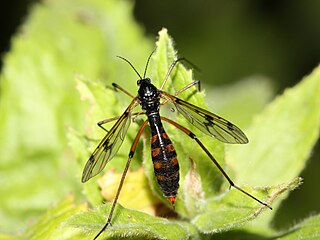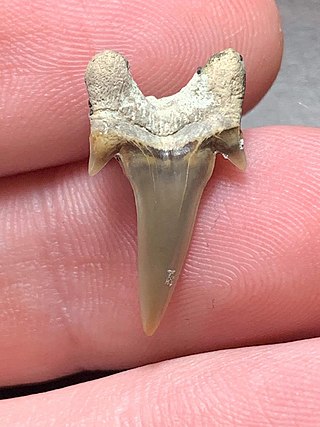
Ceratopogonidae is a family of flies commonly known as no-see-ums, or biting midges, generally 1–3 millimetres in length. The family includes more than 5,000 species, distributed worldwide, apart from the Antarctic and the Arctic.
In geology, Neocomian was a name given to the lowest stage of the Cretaceous system. It is generally considered to encompass the interval now covered by the Berriasian, Valanginian and Hauterivian, from approximately 145 to 130 Ma. It was introduced by Jules Thurmann in 1835 on account of the development of these rocks at Neuchâtel (Neocomum), Switzerland. It has been employed in more than one sense. In the type area the rocks have been divided into two sub-stages, a lower, Valanginian and an upper, Hauterivian ; there is also another local sub-stage, the infra-Valanginian or Berriasian. These three sub-stages constitute the Neocomian in its restricted sense. Adolf von Koenen and other German geologists extend the use of the term to include the whole of the Lower Cretaceous up to the top of the Gault or Albian. Eugène Renevier divided the Lower Cretaceous into the Neocomian division, embracing the three sub-stages mentioned above, and an Urgonian division, including the Barremian, Rhodanian and Aptian sub-stages. Sir A. Geikie regards Neocomian as synonymous with Lower Cretaceous, and he, like Renevier, closes this portion of the system at the top of the Lower Greensand (Aptian). Other British geologists restrict the Neocomian to the marine beds of Speeton and Tealby, and their estuarine equivalents, the Weald Clay and Hastings Sands (Wealden). Much confusion would be avoided by dropping the term Neocomian entirely and employing instead, for the type area, the sub-divisions given above. This becomes the more obvious when it is pointed out that the Berriasian type is limited to Dauphine; the Valanginian has not a much wider range; and the Hauterivian does not extend north of the Paris basin.

Hybodus is an extinct genus of hybodont that lived from the Middle Triassic to the Late Cretaceous periods. Species closely related to the type species Hybodus reticulatus lived during the Early Jurassic epoch. Numerous species have been assigned to Hybodus spanning a large period of time, and it is currently considered a wastebasket taxon that is 'broadly polyphyletic' and requires reexamination.

The Ptychopteridae, phantom crane flies, are a small family of nematocerous Diptera. Superficially similar in appearance to other "tipuloid" families, they lack the ocelli of the Trichoceridae, the five-branched radial vein of the Tanyderidae, and the two anal veins that reach the wing margins of the Tipulidae. They are usually allied with the Tanyderidae based on similarities of the mesonotal suture, this group being called the Ptychopteromorpha.

The Berothidae are a family of winged insects of the order Neuroptera. They are known commonly as the beaded lacewings. The family was first named by Anton Handlirsch in 1906. The family consists of 24 genera and 110 living species distributed discontinuously worldwide, mostly in tropical and subtropical regions. Numerous extinct species have also been described. Their ecology is poorly known, but in the species where larval stages have been documented, the larvae are predators of termites.

Atelestidae is a family of flies in the superfamily Empidoidea. The four genera were placed in a separate family in 1983; they were formerly either in Platypezidae or considered incertae sedis. While they are doubtless the most basal of the living Empidoidea, the monophyly of the family is not fully proven. The genus Nemedina seems to represent a most ancient lineage among the entire superfamily, while Meghyperus is probably not monophyletic in its present delimitation, and it is liable to be split up eventually, with some species being placed elsewhere. In 2010, the genus Alavesia, previously only known from Cretaceous fossils, was found alive in Namibia, subsequent species were also described from Brazil.

The Speeton Clay Formation (SpC) is a Lower Cretaceous geological formation in Yorkshire, northern England. Unlike the contemporaneous terrestrial Wealden Group to the south, the Speeton Clay was deposited in marine conditions. The most common fossils in the unit are belemnites, followed by ammonites and the lobster Meyeria ornata. Dinosaur remains are among the fossils that have been recovered from the formation, although none have yet been referred to a specific genus.

Dwardius is an extinct genus of cardabiodontid sharks which existed during the Cretaceous period in what is now Australia, England, France, and India. It was described by Mikael Siverson in 1999, as a new genus for the species Cretalamna woodwardi, which had been described by J. Hermann in 1977. Another species, D. siversoni, was described from the middle Albian of northeastern France by V.I. Zhelezko in 2000; the species epithet honours the author of the genus. A new species, D. sudindicus, was described by Charlie J. Underwood, Anjali Goswami, G.V.R. Prasad, Omkar Verma, and John J. Flynn in 2011, from the Cretaceous Karai Formation of India.
Eostriatolamia is an extinct genus of sharks in the family Odontaspididae. It was described by Gluckman in 1980. A new species, E. paucicorrugata, was described from the Cenomanian of Canada by Charlie J. Underwood and Stephen L. Cumbaa in 2010.

Meristodonoides is an extinct genus of hybodont. The type species is M. rajkovichi, which was originally a species in the genus Hybodus. The species, along with other Hybodus species such as H. butleri and H. montanensis, was reassigned to Meristodonoides by Charlie J. Underwood and Stephen L. Cumbaa in 2010. The species is primarily known from remains from the Cretaceous of North America, spanning from the Aptian/Albian to Maastrichtian, making it one of the last surviving hybodont genera, though records of the genus likely extend as far back as the Late Jurassic, based on an undescribed skeleton from the Tithonian of England, and fragmentary teeth from the Kimmeridgian of Poland, England and Switzerland. Other remains of the genus are known from the Coniacian of England, the Aptian-Albian of France, and the Campanian of European Russia. The morphology of the teeth suggests an adaptation to tearing prey. Fossils from the Western Interior Seaway suggest that it preferred nearshore marine environments, being absent from deeper-water areas, with it likely also being able to tolerate brackish and freshwater conditions.
Orectoloboides is an extinct genus of wobbegong sharks. It was described by Cappetta in 1977. A new species, O. angulatus, was described from the Cenomanian age of Canada by Charlie J. Underwood and Stephen L. Cumbaa in 2010.
Roulletia is an extinct genus of sand sharks or Haimirichiid shark. It was described by Romain Vullo, Henri Cappetta, and Didier Néraudeau in 2007, and the type species is R. bureaui, which existed during the upper Cenomanian of what is now France. The genus was named after its type locality, Roullet-Saint-Estèphe, while the species epithet honours Michel Bureau, an amateur paleontologist who gathered the material for the species. Another species, R. canadensis, was described from the Cenomanian of Canada by Charlie J. Underwood and Stephen L. Cumbaa in 2010. The species epithet refers to the country in which it was discovered. It has been suggested tentatively this genus may be related to Haimirichia, which has been placed in its own family (Haimirichiidae) based on soft-tissue preservation.

Mesoraphidiidae is an extinct family of snakeflies in the suborder Raphidiomorpha. The family lived from the Late Jurassic through the Late Cretaceous and is known from twenty-five genera. Mesoraphidiids have been found as both compression fossils and as inclusions in amber. The family was first proposed in 1925 by the Russian paleoentomologist Andrey Vasilyevich Martynov based on Upper Jurassic fossils recovered in Kazakhstan. The family was expanded in 2002 by the synonymizing of several other proposed snakefly families. The family was divided into three subfamilies and one tribe in a 2011 paper, further clarifying the relationships of the included genera.

Maimetshidae is an extinct family of wasps, known from the Cretaceous period. While originally considered relatives of Megalyridae, they are now considered to probably be close relatives of Trigonalidae.
The Favel Formation is a stratigraphic unit of Late Cretaceous age. It is present in southern Manitoba and southeastern Saskatchewan, and consists primarily of calcareous shale. It was named for the Favel River near Minitonas, Manitoba, by R.T.D. Wickenden in 1945.
Serphitidae is a family of microscopic parasitic wasps known from the Cretaceous period.
Timeline showing the development of the extinct reptilian order Pterosauria from its appearance in the late Triassic period to its demise at the end of the Cretaceous, together with an alphabetical listing of pterosaur species and their geological ages.

Archaeolamna is an extinct genus of mackerel sharks that lived during the Cretaceous. It contains three valid species which have been found in Europe, North America, and Australia. While it is mostly known from isolated teeth, an associated set of teeth, jaws, cranial fragments, and vertebrae of A. kopingensis is known from the Pierre Shale of Kansas. Teeth of A. k. judithensis were found with a plesiosaur skeleton with bite marks from the Judith River Formation of Montana. It was a medium-sized shark with an estimated total body length of 3–4 metres (9.8–13.1 ft).
Angarosphecidae is an extinct family of Mesozoic and early Cenozoic wasps in the superfamily Apoidea.

Protosqualus was a genus of dogfish shark that existed during the Cretaceous. Fossils have been found in Europe, East Asia, Antarctica, Australia, India and South America. The type species is Protosqualus sigei, which was found around an Albian aged deposit in France. There are 6 species which can be differentiated by distinct features in their teeth. Some species show some level of heterodonty, for example Protosqualus barringtonensis shows a rather high level of heterodonty within its teeth. The oldest specimens are from the Speeton Clay Formation. Protosqualus teeth are quite common in the Grey Chalk deposit of England. The genus went extinct at the end of the Cretaceous during the Cretaceous–Paleogene extinction event, with the last species in the genus being Protosqualus argentinensis from southern Argentina as well as possibly being from earlier deposits in India.











